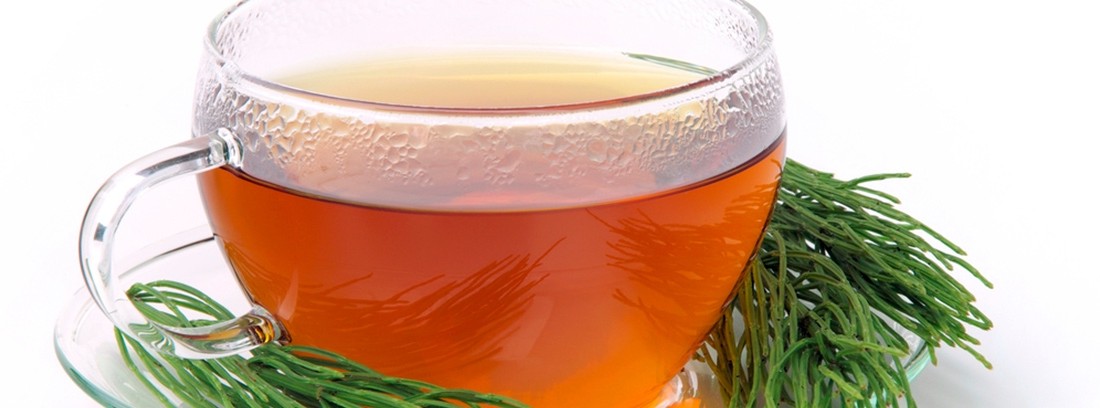Horsetail, a mild diuretic

The horse tail (Equisetum arvense L) is a perennial plant of the Equisettaceae family, common in the northern hemisphere. Native to Europe and northern Asia, it comes from horsetails that formed large forests in the Mesozoic Era. It grows on clay soils or sandy, shaped wild on the banks of rivers and in open fields, provided the area is humid.
- The sterile stems that are collected at the end of the summer are used from the horsetail.
- Due to its content of mineral salts, especially potassium, horsetail has a mild diuretic action, as with.
- It can be taken in the form of herbal tea, in powder, in liquid hydroalcoholic extract (drops) or in capsules of dry extract at different concentrations.
Plant
This plant, which can grow to around eighty centimeters in height, is characterized by presenting two types of stems, some fertile and others sterile. The fertile stems are so called because they are the ones that contain the reproductive organs; They are the first to sprout from its underground rhizome, appear in late winter and spring, are yellowish-brown in color and end in large spikes containing spores. The sterile stems appear in the middle of summer dying in the winter; they are hollow, ribbed and articulated with numerous lateral twigs.
The reason for his name
Once cut, the sterile stem bundles reminiscent of a horse's tailHence its botanical name, equisetum, which comes from the Latin equus which means "horse" and setum which means "mane or bristle", which was translated in medieval Castilian as "cauda equina", from where the current common name of "horse tail".
Its use in the past
The use of horsetail for medicinal purposes dates back to ancient times. Pliny the Elder (23-79 AD) cited that the horsetail had hemostatic virtues and that its contact served to stop bleeding wounds, and Galen (130-200 AD) already mentioned his diuretic properties. In the Middle Ages, the renowned doctor and religious Arnau de Vilanova describes that he used it to cure a fistula after having heard from another colleague of his properties healing.
Current uses
Due to its content of mineral salts, especially potassium, horsetail has a diuretic action gentle. Among the mineral salts, its high content of silicon also stands out, so its powder, ingested, is traditionally used as remineralizing to strengthen hair and nails. Some authors defend that its richness in silicon can make horsetail useful as an aid for the maintenance of collagen in connective tissue, especially in the joints. Due to its content in and other substances it has action antioxidant. It has also been observed in different scientific studies that, due to the volatile components it contains, it has an action antimicrobial, against different bacteria and fungi.
The European Medicines Agency (EMA), in its monograph, considers its traditional use as a diuretic for "flushing the urinary tract". Other monographs, such as that of the German Commission E, also mention its healing properties, in topical use (on the skin) for wound healing.
In a traditional way, it is used, due to its mild diuretic property, as an aid in the treatment of overweight.
How to take it?
EMA recommended dosage (adults and adolescents over 12 years of age):
- herbal tea: 2 to 3 g in 250 ml, 3 to 4 times a day.
- Dust: 570 mg, 3 to 4 times a day.
Horsetail, in commercial form, is also in liquid hydroalcoholic extract form (drops) or in capsules of dry extract at different concentrations, it is advisable not to exceed the doses recommended by the manufacturers.
For external use, the German Commission E monograph recommends its use in the form of compresses or washes, from a herbal tea made with 10 g of sterile horsetail stems in 1 liter of water.
HOW TO PREPARE A TISANA
When the water boils, add the horsetail, leave for a couple of minutes, turn off the heat and let it rest until it is warm. Strain and drink or use as a wash or compress. To drink, you can prepare all the herbal tea that is to be used during the day, but it must be kept strained and covered. In this case, if you want to drink hot, you must ensure that it does not boil again when heated. For external use, in compresses or washes, it is advisable to prepare each time it is to be used.
Contraindications, adverse effects and recommendations
- In case of or of heart problems It should only be used under medical supervision. -It should not be used with diuretic drugs because it can enhance their effect and an excess of diuresis is harmful. It should also not be used with antihypertensive medications without the supervision of a health professional (doctor or pharmacist).
- Its use is discouraged during and after lactation.
- In case of overdose, stomach pain, heartburn, nausea, vomiting, dry mouth, dizziness, confusion, palpitations, drowsiness or hypertension may appear.
- Must not be collected in the field if you do not have botanical knowledge, since Equisetum arvense can easily be confused with another very similar species, Equisetum palustre, of which, although the toxicity that it can have in humans is not well understood, serious poisonings have been observed in herbivorous animals.
(Updated at Apr 14 / 2024)